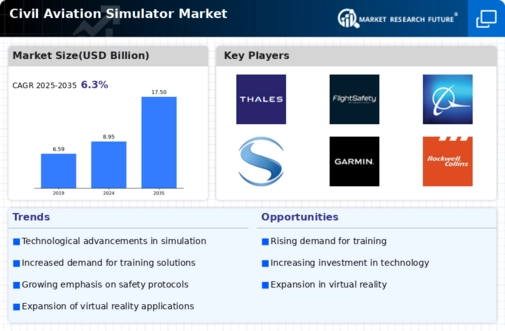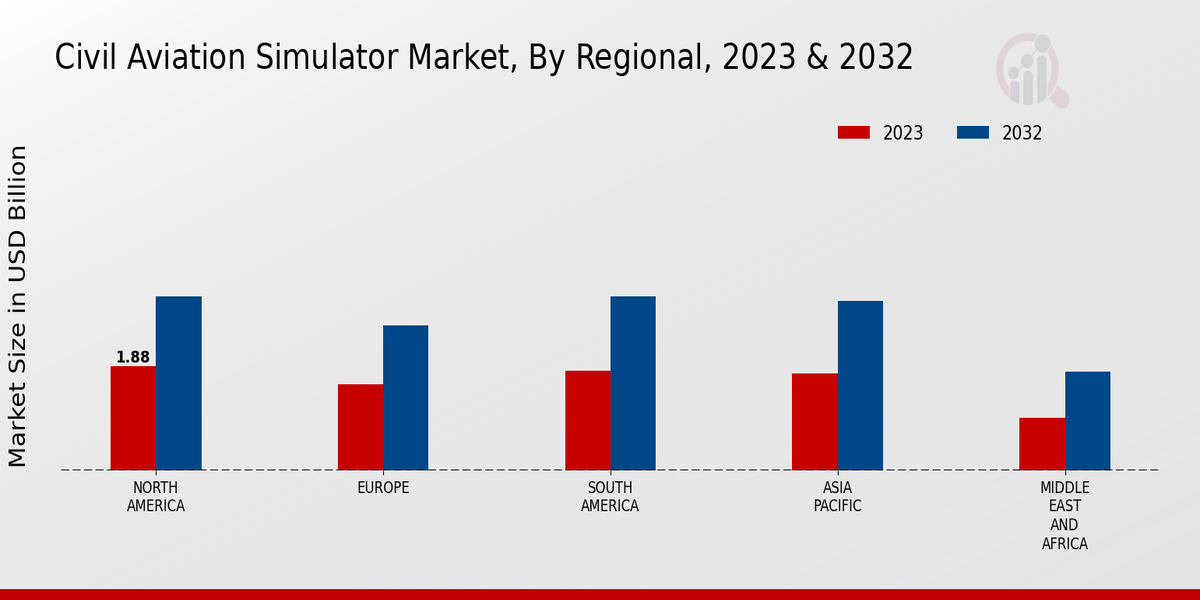Market Growth Projections
The Global Civil Aviation Simulator Market Industry is projected to experience substantial growth in the coming years. By 2024, the market is valued at 8.95 USD Billion, with expectations to reach 17.5 USD Billion by 2035. This growth trajectory indicates a robust demand for flight simulation technologies, driven by factors such as increasing pilot training needs, technological advancements, and regulatory compliance. The anticipated CAGR of 6.29% from 2025 to 2035 further emphasizes the market's potential for expansion, as stakeholders invest in innovative solutions to enhance training efficiency and safety in the aviation sector.
Expansion of the Aviation Sector
The Global Civil Aviation Simulator Market Industry is benefiting from the ongoing expansion of the aviation sector. As air travel becomes increasingly accessible, airlines are expanding their fleets and routes, necessitating a larger pool of trained pilots. This growth in the aviation industry drives demand for flight simulators, which are essential for training new pilots efficiently. The market's valuation of 8.95 USD Billion in 2024 reflects this trend. Furthermore, as airlines invest in training infrastructure to support their growth, the market is poised for continued expansion, with expectations of reaching 17.5 USD Billion by 2035.
Increasing Demand for Pilot Training
The Global Civil Aviation Simulator Market Industry is experiencing heightened demand for pilot training solutions. As the aviation sector expands, the need for qualified pilots intensifies. In 2024, the market is valued at 8.95 USD Billion, reflecting the industry's commitment to enhancing training methodologies. Flight simulators provide a safe and controlled environment for pilots to hone their skills, thereby reducing training costs and improving safety outcomes. The projected growth rate of 6.29% CAGR from 2025 to 2035 further underscores the necessity for advanced training tools, as airlines and training institutions seek to meet regulatory requirements and ensure operational efficiency.
Technological Advancements in Simulation
Technological innovations are significantly shaping the Global Civil Aviation Simulator Market Industry. The integration of virtual reality, augmented reality, and artificial intelligence into flight simulators enhances realism and training effectiveness. These advancements allow for more immersive training experiences, which can lead to better retention of skills and knowledge among pilots. As the market evolves, the demand for high-fidelity simulators is likely to increase, driving growth. By 2035, the market is expected to reach 17.5 USD Billion, indicating a robust investment in cutting-edge simulation technologies that cater to the evolving needs of the aviation industry.
Regulatory Compliance and Safety Standards
Regulatory compliance plays a crucial role in the Global Civil Aviation Simulator Market Industry. Aviation authorities worldwide mandate rigorous training and certification processes for pilots, which necessitate the use of advanced simulators. These simulators not only help in meeting regulatory requirements but also enhance safety standards within the industry. As airlines strive to maintain compliance and improve safety records, the demand for sophisticated simulation solutions is likely to rise. This trend is expected to contribute to the market's growth, with a projected CAGR of 6.29% from 2025 to 2035, as stakeholders prioritize safety and regulatory adherence.
Globalization and International Training Standards
Globalization is influencing the Global Civil Aviation Simulator Market Industry by promoting international training standards. As airlines operate across borders, the need for standardized training programs becomes paramount. Flight simulators are integral to achieving these standards, ensuring that pilots receive consistent training regardless of their location. This trend is likely to drive demand for advanced simulation technologies that can accommodate diverse regulatory environments. The market's growth trajectory, with a projected CAGR of 6.29% from 2025 to 2035, suggests that stakeholders are increasingly recognizing the importance of aligning training practices with global standards.






















Leave a Comment